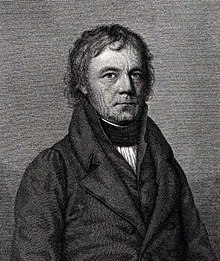Leander van Ess
Leander van Eß (also Johann Heinrich van Eß , born February 15, 1772 in Warburg in the Principality of Paderborn ; † October 13, 1847 in Affolterbach , Odenwald ) was a Catholic theologian and author of a translation of the Bible into German.
Life
Van Eß attended the Marianum grammar school in Warburg and in 1790 became a Benedictine in Marienmünster near Paderborn, where he took the monastery name Leander and was ordained priest in 1796 . After the abolition of the monastery in 1802, he moved to Schwalenberg (Lippe) and worked as a pastor . From 1812 he was a professor at the University of Marburg , co-director of the school teachers' seminar there and pastor of the parish of Marburg. He resigned from all offices in 1822 and then lived in Darmstadt and from 1835 in Alzey as a private scholar. Leander van Eß collected a large number of manuscripts and printed old books. He dedicated himself in particular to the creation of a German translation of the Bible and the dissemination of the Bible among the people, which made him a forerunner of the Catholic Bible movement of the 19th century.
Together with his cousin Karl van Eß , he translated the New Testament , which appeared in Braunschweig in 1807 , while he was still active as a priest or pastor . The Vulgate served as the basis , with an extensive set of footnotes indicating differences to the Greek text. Leander van Eß also created an edition of the Bible himself in 1827 - a combination of the Complutensic Polyglot and the Erasmic Text .
Between 1807 and 1821, several bishoprics and theological faculties granted their license to translate. However, the Catholic Church criticized van Ess' publicly expressed opinion on various doctrines and set his New Testament on December 19, 1821 on the Index Librorum Prohibitorum . After various textual adjustments, in 1822 the Catholic Theological Faculty of the University of Tübingen and in 1826 the Episcopal General Vicariate in Bruchsal declared the translation to be in accordance with the teachings of the Catholic Church and recommended the new editions for approval.
Working alone, the translation of the Old Testament from the original followed, which appeared in a first part in 1822 and a second part in 1836. Together with Heinrich Joseph Wetzer , he finally published a three-part complete edition of his work in 1840. Due to the translation from Hebrew, the numbering of the Psalms follows the classification of Robert Estienne and thus differs from that of the Vulgate and other earlier Catholic Bible translations. As a further specialty, early editions consistently reproduce the tetragram in the form of Jehovah .
Reading sample
Matthew 18: 23-24 (based on an edition of the British and Foreign Bible Society , Vienna 1950):
“That is why the heavenly kingdom is like a king who wanted to settle accounts with his servants. When he began to settle accounts, someone came before him who owed him ten thousand talents. "
literature
- Leander van Eß: The Holy Scriptures of the Old and New Testament, translated by D. Leander van Eß , British and Foreign Bible Society, Vienna 1950.
- Johannes Altenberend: Leander van Eß . Bonifatius Buchverlag, 2001, ISBN 3-89710-177-7
- Leander van Eß: The Holy Scriptures , British and Foreign Bible Society, Vienna 1884, title page: "The translation of the Old Testament is according to the basic texts."
- Hermann Knaus: van Eß, Leander. In: New German Biography (NDB). Volume 4, Duncker & Humblot, Berlin 1959, ISBN 3-428-00185-0 , p. 656 ( digitized version ).
- Franz Heinrich Reusch : Eß, Leander van . In: Allgemeine Deutsche Biographie (ADB). Volume 6, Duncker & Humblot, Leipzig 1877, p. 378 f.
- Friedrich Wilhelm Bautz: Ess, Leander van. In: Biographisch-Bibliographisches Kirchenlexikon (BBKL). Volume 1, Bautz, Hamm 1975. 2nd, unchanged edition Hamm 1990, ISBN 3-88309-013-1 , Sp. 1544-1545.
Web links
- Works by and about Leander van Eß in the German Digital Library
- Bible editions by Leander van Eß
- Directory of the collections of Eß '
| personal data | |
|---|---|
| SURNAME | Eß, Leander van |
| ALTERNATIVE NAMES | Eß, Johann Heinrich van |
| BRIEF DESCRIPTION | Author of a German translation of the Bible |
| DATE OF BIRTH | February 15, 1772 |
| PLACE OF BIRTH | Warburg |
| DATE OF DEATH | October 13, 1847 |
| Place of death | Affolterbach , Odenwald |

